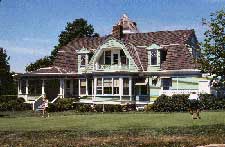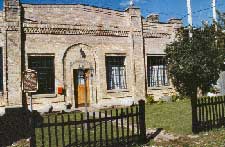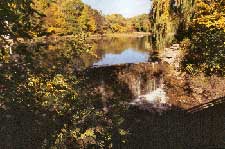MILWAUKEE COUNTY LANDMARKS
South Milwaukee
 Grant Park Clubhouse
Grant Park Clubhouse
100 Hawthorne Avenue
South Milwaukee
Landmark Designation: 1978
Grant Park, the site of Milwaukee County’s first 18-hole golf course was developed in 1919 along the Lake Michigan shore south of Cudahy. Land for the park was purchased from Horace Fowle, son of early pioneers who had come to Oak Creek in 1835. The Commission also purchased Fowle’s lovely Victorian home which had been built in 1892 on the site of his family’s log cabin. Minimal changes were necessary to convert the house to a golf clubhouse and much of the Victorian charm remains. A veranda winds around the first floor and an enclosed porch in the turret has a fine view of Lake Michigan. The original staircase with carved balustrades and newel posts is intact. A buffet with floor-to-ceiling cabinets divides the dining room from the kitchen. A small sitting room occupies an alcove which formerly housed a musician’s platform. The starting booth for the golf course now stands where visitors once tied their horses.
 Lawson Aircraft / Continental Tile and Faience Building
Lawson Aircraft / Continental Tile and Faience Building
909 Menomonee Avenue
South Milwaukee
Landmark Designation: 2002
Constructed between 1916 and 1928, this long, narrow, black structure housed Lawson Airplane Factory, which designed the first two airplanes built for commercial aviation in 1919 and 1920. Through this company, Alfred Lawson was the first to propose a nationwide commercial passenger service representing a significant period in transportation history.
Referred to at the time as “the Columbus of the air,” his planes had 120 foot wingspread and flew at 120 miles per hour. He also initiated several modern standard features of the commercial airline business, such as weather-proof cockpits, dual pilot control, and passenger cabins with a center isle. While the first plane was taking its initial flight, the furrows in the ground during takeoff caused it to veer off course running into a tree and telephone pole. This disaster led to the company’s bankruptcy since stockholders refused to put up the $10,000 needed for repairs.
The second of the building’s owners, Continental Faience and Tile Company, created a sophisticated, finely detailed and vibrantly colored three-dimensional advertising brochure for their products. The structure is important for the high artistic expression of the tilework in the vestibule, manager’s office and showroom. A previous owner, Dick Schumacher, repaired much of the original structure.
 South Milwaukee Railroad Depot
South Milwaukee Railroad Depot
1111 Milwaukee Avenue
South Milwaukee
Landmark Designation: 2002
When the railroad first came to South Milwaukee in 1855, the depot was no more than a small wooden platform. In 1851, the State of Illinois had chartered the lakeshore suburban service from the North West Railroad to run from Chicago to the Wisconsin state line. The same year, Wisconsin chartered its own rail service, the Green Bay, Milwaukee and Chicago Railroad heading toward the state line from the north. These met up four years later, and Chicago and Milwaukee were connected by rail.
In 1864, the original station was moved to its present location at 11th and Milwaukee from 10th and Rawson. In 1891, members of the South Milwaukee Company began to develop the area into a permanent manufacturing and residential city. This group recognized the need for a new depot to match the growing expectations of the budding town. Both the company and the railroad donated money for construction which was completed in 1893. The depot was built by Charles Sumner Frost, a well-known architect with many depots to his credit, including depots in Ashland, Beloit, Eau Claire, Fond du Lac, Fort Atkinson, Lake Geneva, Manasha, Milwaukee, Oconomowoc, Rhineland, and Wausau. The structure was finished in red brick and detailed in brownstone. The depot provided regular service though the 1950s and has undergone very few modifications. Benkowski Building Inc. first occupied the Depot in 1983.
 Oak Creek Dam
Oak Creek Dam
South Milwaukee
Landmark Designation: 2003
This first dam to receive the honors of a local landmark is located near the mouth of the Oak Creek River in South Milwaukee. Built by John Fowle in the early 1840s, this dam helped operate both a gristmill and a sawmill. Fowle’s mill was the second built here after the first was destroyed by ice and high water. The original Oak Creek settlement consisted only of a few houses, a stage station, and a tavern but later became the City of South Milwaukee. In 1867, Charles Ahrens bought the mill and refitted it with new machinery and strengthened the dam. His changes doubled the mill’s production from 25 to 50 barrels of flour per day. The mill was torn down in 1932. The millstones, thought to be the oldest man-made items in South Milwaukee survive on the site and can be seen lying on either side of the dam. The original dam was made of wood and had a wagon road over it, but was rebuilt by the WPA in the mid-1930s. It is now owned by Milwaukee County and is part of the Oak Creek parkway.




